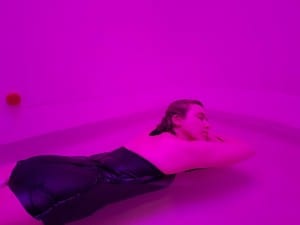At Float Lab in Venice, Calif, adults of all ages ease themselves into individual salt water tanks to let the external world bob away. While once known by the less friendly names of “sensory deprivation” or “isolation” chambers, today “flotation tanks”—which are light-controlled, sound-resistant, and filled with skin-temperature water and enough dissolved salt to allow users to effortlessly stay afloat—are sought out by consumers who say floating helps with conditions ranging from stress management to writer’s block.
Some use the float tanks for sleep health, including as an alternative therapy for insomnia. I asked the owner of Float Lab-Venice—a man who goes only by the name “Crash” and who has run the location for more than 15 years—about floating and sleep before my first appointment at his newer Westwood, Calif, location.
“People always say they sleep better after floating. I know I do,” Crash told me via phone. “It’s like if you were a can full of pressure and you went to bed with all of the pressure on you still. With floating, it’s as if you pop the top, let the pressure out, and then go to bed.” In essence, Crash described floating as part of a pre-bedtime wind-down routine. This is emphasized when I asked what time a person hoping for sleep improvement should reserve a tank: right before bed, he responded. (Both locations are open until 11 pm.)
While Crash’s facilities are basic (light-free and almost silent, with earplugs provided), some float tanks offer upgraded sleep-promoting amenities. For example, tanks by manufacturer/distributor Float Rooms USA feature LED lights that are designed for circadian entrainment and a sound system that can pipe in guided meditation. Float therapy is especially popular with shift workers, Float Rooms USA co-owner Cheri Koene told me over the phone, adding that some companies have added float therapy to their employee wellness programs.
My appointment at Float Lab-Westwood, from 1:30 to 3:30 pm, was intentionally scheduled during my typical workday circadian dip. Once in the tank, I mostly kept my eyes closed, because then the pitch blackness seemed natural. After a few minutes, I trusted the water to support my body. I considered napping, but that may have been too ambitious for a first-visit goal. I typically fall asleep on my side, but supine was the only comfortable position in the tank to avoid water entering my eyes, nose, or mouth. (I later learned that some centers have raised pillows for side or stomach floating.) Still, I felt I reaped some benefits from the experience, including a zen-like calm on my drive home and a rejuvenating nap later. Though I’d been feeling run-down earlier in the day, by the next morning I felt energetic and healthy.

Sree Roy
[email protected]
I asked sleep specialist Rubin Naiman, PhD, if he could provide insights as to the mechanism behind floating helping some users with sleep. I’d theorized it may be similar to the effects of a warm bath, in which the temperature drop is credited. Naiman responded via email, “I think part of its effect might be similar to a warm bath but suspect it’s more. The tanks certainly promote relaxation by reducing arousal. Sensory deprivation also tends to drive attention inward—toward what I would call a waking dream. I think this is similar to the hypnagogic state—a natural transition to sleep.” I asked him if he’d recommend float tanks to patients to alleviate sleep issues. “I wouldn’t discourage it but would need to see some supportive research before I endorse it,” he said.
A group of UCLA students recently conducted research at Float Lab-Venice. Tellingly, of the 40 respondents, 87.5% said they would like to experience a float tank again—evidence that, for some, float therapy conveys worthwhile benefits.
Sree Roy is editor of Sleep Review. Email sroy[at]allied360.com.




Since the article publication in April I have met with medical professionals regarding sleep apnea as well as TMJ an TMD issues of my own. I am pleased to inform Sleep Review that this article has raised awareness of sleep and oralmaxofacial issues affecting millions of americans and myself Cheri owner of float center shiloh.http://floatcentershiloh.com/
Sleep Review Staff is Great to Work With